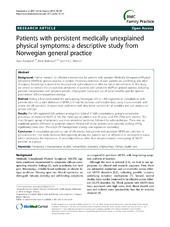| dc.contributor.author | Aamland, Aase | en_US |
| dc.contributor.author | Malterud, Kirsti | en_US |
| dc.contributor.author | Werner, Erik L. | en_US |
| dc.date.accessioned | 2016-01-04T13:15:11Z | |
| dc.date.available | 2016-01-04T13:15:11Z | |
| dc.date.issued | 2014-05-29 | |
| dc.Published | BMC Family Practice 2014, 15(1) | eng |
| dc.identifier.issn | 1471-2296 | |
| dc.identifier.uri | https://hdl.handle.net/1956/10858 | |
| dc.description.abstract | Background Further research on effective interventions for patients with peristent Medically Unexplained Physical Symptoms (MUPS) in general practice is needed. Prevalence estimates of such patients are conflicting, and other descriptive knowledge is needed for development and evaluation of effective future interventions. In this study, we aimed to estimate the consultation prevalence of patients with persistent MUPS in general practice, including patients’ characteristics and symptom pattern, employment status and use of social benefits, and the general practitioners’ (GPs) management strategy. Method During a four-week period the participating Norwegian GPs (n = 84) registered all consultations with patients who met a strict definition of MUPS (>3 months duration and function loss), using a questionnaire with simple tick-off questions. Analyses were performed with descriptive statistics for all variables and split analysis on gender and age. Results The GPs registered 526 patients among their total of 17 688 consultations, giving a consultation prevalence of persistent MUPS of 3%. The mean age of patients was 46 years, and 399 (76%) were women. The most frequent group of symptoms was musculoskeletal problems, followed by asthenia/fatigue. There was no significant gender difference in symptom pattern. Almost half of the patients were currently working (45%), significantly more men. The major GP management strategy was supportive counseling. Conclusion A consultation prevalence rate of 3% implies that patients with persistent MUPS are common in general practice. Our study disclosed heterogeneity among the patients such as differences in employment status, which emphasizes the importance of personalized focus rather than unsubstantiated stereotyping of “MUPS patients” as a group. | en_US |
| dc.language.iso | eng | eng |
| dc.publisher | BioMed Central | eng |
| dc.rights | Attribution CC BY | eng |
| dc.rights.uri | http://creativecommons.org/licenses/by/4.0 | eng |
| dc.subject | Somatoform disorders | eng |
| dc.subject | Primary health care | eng |
| dc.subject | Cross-sectional studies | eng |
| dc.title | Patients with persistent medically unexplained physical symptoms: A descriptive study from Norwegian general practice | en_US |
| dc.type | Peer reviewed | |
| dc.type | Journal article | |
| dc.date.updated | 2015-11-26T08:36:19Z | |
| dc.description.version | publishedVersion | en_US |
| dc.rights.holder | Copyright Aamland et al.; licensee BioMed Central Ltd. 2014 | |
| dc.identifier.doi | https://doi.org/10.1186/1471-2296-15-107 | |
| dc.identifier.cristin | 1136447 | |
| dc.subject.nsi | VDP::Medisinske fag: 700::Klinisk medisinske fag: 750::Allmennmedisin: 751 | |
| dc.subject.nsi | VDP::Midical sciences: 700::Clinical medical sciences: 750::General practice: 751 | |
| dc.subject.nsi | VDP::Medisinske Fag: 700 | en_US |

